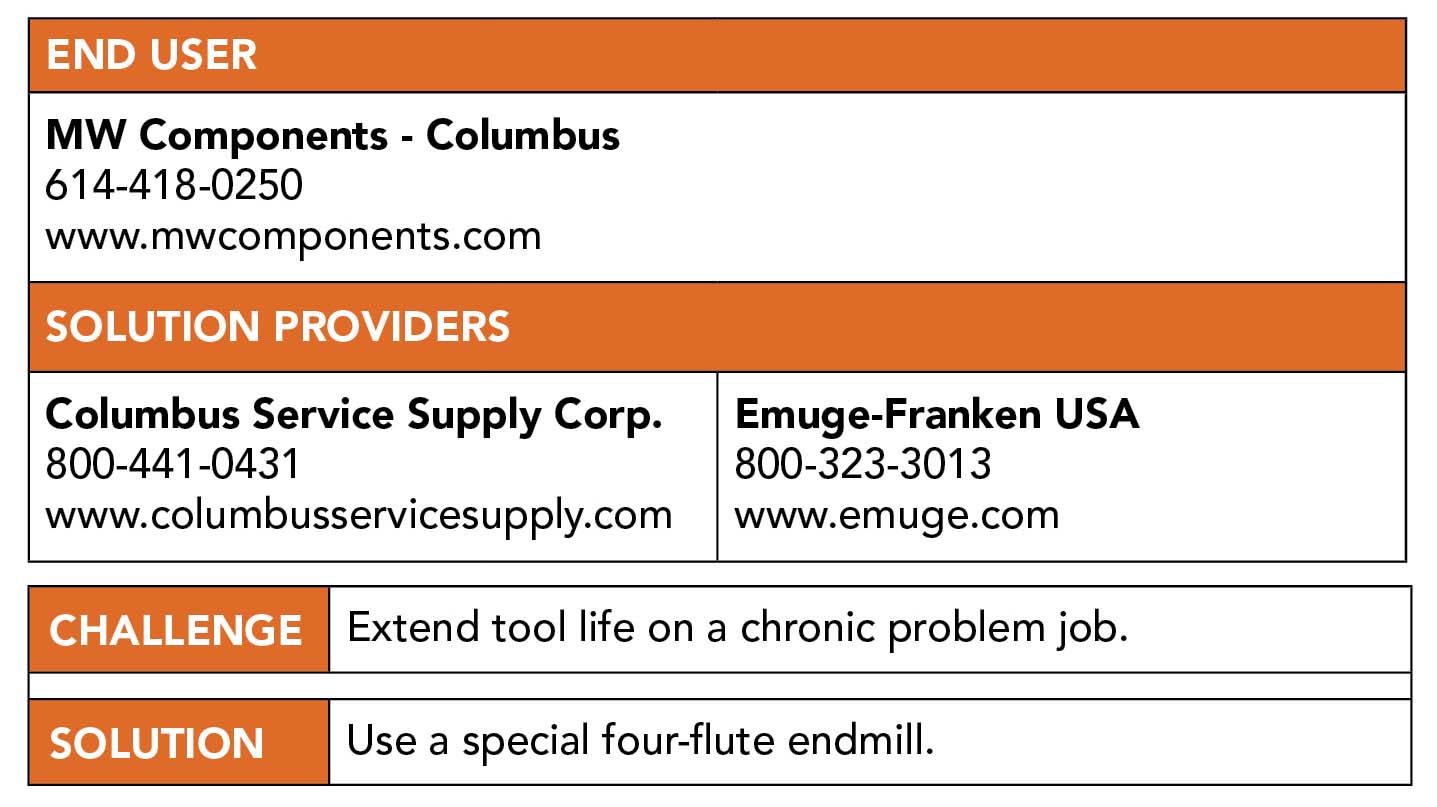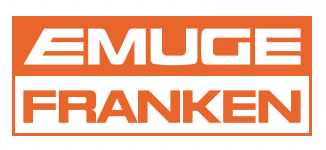Like many in his position, Tommy Coulter likes to put cutting tools to the test from time to time. A CNC programmer and tool and die maker for MW Components - Columbus in Columbus, Ohio, he calls this continuous improvement exercise “drag racing,” a process that involves bringing in multiple suppliers to see who has the best cutting tool to solve a particular machining problem.
He undertook such an exercise late last summer and reported an “award-winning” experience. With assistance from his cutting tool distributor and Emuge-Franken USA in West Boylston, Massachusetts, the shop was able to increase tool life 10 times compared with the endmill he’d been using for several years, saving the company more than $31,000 on one job alone.
“I expected some amount of improvement in tool wear,” Coulter said. “But to be honest, we were all a little shocked at the results.”
Formerly known as Capital Spring Co., MW Components - Columbus has produced springs, wire forms and small metal stampings since 1945. It uses CNC coiling technology and high-performance machine tools and stamping equipment to improve throughput, increase repeatability and reduce costs for customers.

The company hired Coulter six years ago, and one of his more immediate tasks at that time was tooling up for a family of high-volume specialty automotive springs. So he went drag racing. The original project included purchasing an Okuma four-axis MB-4000H horizontal machining center, along with the tombstones, fixtures and toolholders needed to process workpieces in batches of 14 to 20 per tombstone face, depending on the part number.
The application involved milling a feature on the end of a 9.525 mm-dia. (0.375") piece of 4140 steel with a hardness from 28 to 32 HRC, one that had been turned on a screw machine and then bent into a specific shape.
“And that was the root of the problem,” Coulter said. “The part and cutting tool alike have to stick out a long way in order to clear one of the bends, and there’s simply no way to stabilize it. Picture a pencil that’s standing straight up and then trying to machine it with a tool 3" (76.2 mm) long. There are some serious flex issues going on there.”
Despite these challenges, he was able to develop a sufficiently stable process, so the company has been making the part for nearly five years. The only problem was the need to stop the machine every 300 parts to change endmills, a chronic headache that he’d tried repeatedly — and unsuccessfully — to eliminate.
In the spirit of drag racing, Coulter reached out to Jason Frye, area sales representative for cutting tool and industrial equipment supplier Columbus Service Supply Corp. in Worthington, Ohio. Frye took one look at the application and reached out to Emuge-Franken.

“Emuge asked me what I was looking for in a cutting tool, and I explained that side loading was a huge issue,” Coulter said. “I was using a trochoidal milling technique with a high-quality, extended-length cutter, but it wasn’t enough. We needed an endmill that would minimize cutting forces as much as possible. This would eliminate the flexing and hopefully improve tool life.”
Evan Duncanson, milling application specialist at Emuge-Franken, went to work with his team and engineered and manufactured a special.
“We basically combined two of our standard tool geometries into one,” he said. “Our intent was to replicate what the customer was using but put our own spin on it. So our technical team in West Boylston, Massachusetts, went to work developing the best design and microgeometry possible for the application, ultimately delivering an extended-reach, 10 mm (0.394"), four-flute endmill with a series of NF-style chipbreakers along its length and our ALCR coating for wear resistance.”
Within the first day of use, Coulter saw a big difference in tool life.
“I ended up making 3,000 parts on the first job,” he said, “and the new tool still looked good. You could tell right away by the sound that it was a lot freer cutting than the last endmill. I’m not privy to how they made it, but I do know one thing for sure: It works. Over the past several years of trying different tools, I haven’t seen anything that comes even close.”
As with all successful drag races, Coulter’s next step is to tweak the operating parameters in an attempt to squeeze more out of the new tool.
“It’s an ever-evolving process,” he said. “But for now, we’re just enjoying the benefits as is, which I figure is at least 20 minutes per shift less downtime and a whole lot less money spent on carbide (tools). It’s already well worth the higher price for a custom tool. But once we start dialing in the speeds and feeds to further increase productivity, I predict some very significant cost
savings.”
Contact Details
Related Glossary Terms
- computer numerical control ( CNC)
computer numerical control ( CNC)
Microprocessor-based controller dedicated to a machine tool that permits the creation or modification of parts. Programmed numerical control activates the machine’s servos and spindle drives and controls the various machining operations. See DNC, direct numerical control; NC, numerical control.
- endmill
endmill
Milling cutter held by its shank that cuts on its periphery and, if so configured, on its free end. Takes a variety of shapes (single- and double-end, roughing, ballnose and cup-end) and sizes (stub, medium, long and extra-long). Also comes with differing numbers of flutes.
- gang cutting ( milling)
gang cutting ( milling)
Machining with several cutters mounted on a single arbor, generally for simultaneous cutting.
- hardness
hardness
Hardness is a measure of the resistance of a material to surface indentation or abrasion. There is no absolute scale for hardness. In order to express hardness quantitatively, each type of test has its own scale, which defines hardness. Indentation hardness obtained through static methods is measured by Brinell, Rockwell, Vickers and Knoop tests. Hardness without indentation is measured by a dynamic method, known as the Scleroscope test.
- machining center
machining center
CNC machine tool capable of drilling, reaming, tapping, milling and boring. Normally comes with an automatic toolchanger. See automatic toolchanger.
- milling
milling
Machining operation in which metal or other material is removed by applying power to a rotating cutter. In vertical milling, the cutting tool is mounted vertically on the spindle. In horizontal milling, the cutting tool is mounted horizontally, either directly on the spindle or on an arbor. Horizontal milling is further broken down into conventional milling, where the cutter rotates opposite the direction of feed, or “up” into the workpiece; and climb milling, where the cutter rotates in the direction of feed, or “down” into the workpiece. Milling operations include plane or surface milling, endmilling, facemilling, angle milling, form milling and profiling.
- sawing machine ( saw)
sawing machine ( saw)
Machine designed to use a serrated-tooth blade to cut metal or other material. Comes in a wide variety of styles but takes one of four basic forms: hacksaw (a simple, rugged machine that uses a reciprocating motion to part metal or other material); cold or circular saw (powers a circular blade that cuts structural materials); bandsaw (runs an endless band; the two basic types are cutoff and contour band machines, which cut intricate contours and shapes); and abrasive cutoff saw (similar in appearance to the cold saw, but uses an abrasive disc that rotates at high speeds rather than a blade with serrated teeth).
- wear resistance
wear resistance
Ability of the tool to withstand stresses that cause it to wear during cutting; an attribute linked to alloy composition, base material, thermal conditions, type of tooling and operation and other variables.



